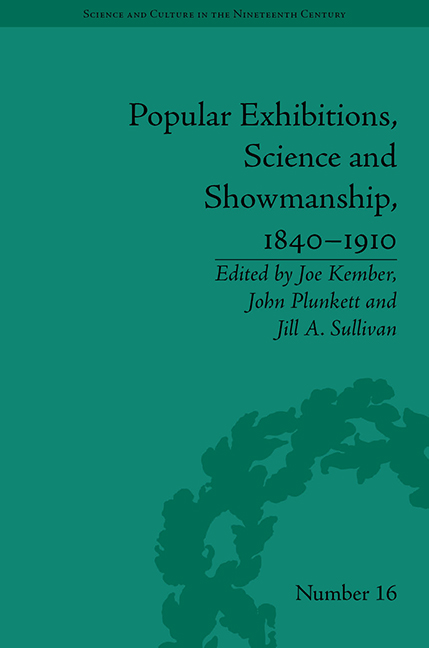Book contents
- Frontmatter
- CONTENTS
- Acknowledgements
- List of Contributors
- List of Figures and Tables
- Introduction
- Part I Science and Spectacle
- 1 Spectacle in Leicester Square: James Wyld's Great Globe, 1851–61
- 2 Fetes, Bazaars and Conversaziones: Science, Entertainment and Local Civic Elites
- 3 The Afterlife of Freak Shows
- Part II Word and Image
- Part III Staging Knowledge
- Part IV The Politics of Display
- Notes
- Index
2 - Fetes, Bazaars and Conversaziones: Science, Entertainment and Local Civic Elites
from Part I - Science and Spectacle
- Frontmatter
- CONTENTS
- Acknowledgements
- List of Contributors
- List of Figures and Tables
- Introduction
- Part I Science and Spectacle
- 1 Spectacle in Leicester Square: James Wyld's Great Globe, 1851–61
- 2 Fetes, Bazaars and Conversaziones: Science, Entertainment and Local Civic Elites
- 3 The Afterlife of Freak Shows
- Part II Word and Image
- Part III Staging Knowledge
- Part IV The Politics of Display
- Notes
- Index
Summary
Our understanding of the range of exhibition spaces for Victorian popular science, and the correspondingly diverse experiences they provided for audiences, has undergone significant modification over the last ten years. Whilst metropolitan establishments such as the Royal Polytechnic Institution, Egyptian Hall, Wyld's Great Globe and Royal Adelaide Gallery probably remain the best-known known examples of institutions providing a potent mixture of instruction, amusement and spectacle, a wealth of recent scholarship has demonstrated that there was also an increasing variety of alternative exhibition spaces that have been for too long in the shadow of these large and iconic London establishments. A trip to the Polytechnic or Egyptian Hall might well form part of the itinerary of a visitor to London; for most though, such trips were the exception rather than the rule. Two key research trends have driven this emergence of a more nuanced picture of Victorian popular science. The first is a move away from studies of the metropolis towards an exploration of the provision of lectures, demonstrations, classes and exhibitions in British provincial towns and cities. For inhabitants of towns and cities beyond London (and potentially for many Londoners as well), a lecture at the local mechanics' institute, a magic lantern show of natural history given as a Sunday school treat, the hullabaloo of a travelling menagerie arriving in the marketplace, or a freak show at the annual fair were more likely to have constituted their experiences of popular science.
- Type
- Chapter
- Information
- Popular Exhibitions, Science and Showmanship, 1840–1910 , pp. 41 - 60Publisher: Pickering & ChattoFirst published in: 2014



